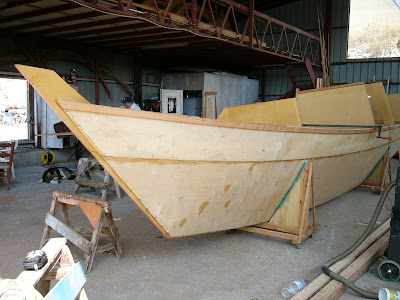It is a long time since I have last updated this blog but I have an excuse for that: It was a summer so full of windsurfing, sailing, boatbuilding and camping that I didn’t manage to find the time to send a post!
At the end of July, my friend Aris and I managed to finish the repair work needed on the Tiki 21 he had bought from an old English couple earlier this year. Our estimations from the first time we saw the boat were correct: There were only minor damages that required attention and most of the work done was painting, antifouling, applying new non skid on decks etc.
We launched the boat in August and since then she was sailed in the local sea conditions at this time of the year extensively. Although we didn’t have any experience at all in sailing catamarans, let alone Wharram’s, the boat looked after us at all times! She seemed very stable in forces of wind up to 4-5B and we had to reef only if there were larger waves ( more than 80cm-1m). The boat was also very fast on a reach or downwind. However, although we could sail as close as 40-450 to the wind and maintain a reasonable speed, we had some serious trouble tacking at first. After a while, taking advantage of the Wharram’s tacking technique described in the Tiki 21 set of plans and some advice from other Wharram sailors, we managed to correct our mistakes and to get the hang of it! The link bellow is from a short video on You Tube of Aris’s boat sailing off Heraclion coastline with an unsuccessful attempt to tack and then a successful gibe.
http://www.youtube.com/watch?v=p83lbRClasQ&feature=email
There was also some significant progress on my Tiki 31! The large traditional kaique that was being built, was launched at the end of August so my boat came down from the loft and out of the hibernation…
After a good cleaning we started again from where we had left it. The upper hull sides are now glued on the starboard hull and all the fillets done. By the end of next week I hope the decks will also be on place, along with the beam throughs on Bk 5 and 7 so as to enclose the central cockpit.
On the port hull everything is ready for the floors to be installed, except from some painting in the bilges. I am using three coats of Hempel’s Light Primer for this on top of three coats of clear epoxy. There is no need for UV protection of the epoxy in the bilges since the sunlight will never reach it. All the floors and bunks for the port hull are reinforced with pieces of pitch pine glued and filleted on their under side and coated with three coats of epoxy. As soon as the painting is done they will be installed as well. I still have a few details to clarify concerning the new form of the cabins but I think that as soon as the beam throughs are finished everything will be on its way!




















































